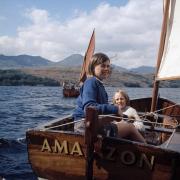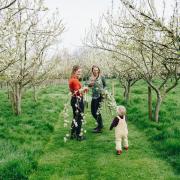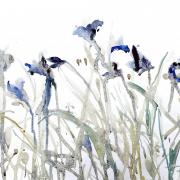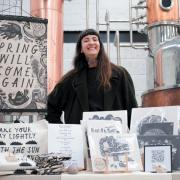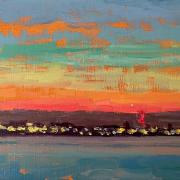Harbouring an untapped skill for half his life, the talent of Southampton artist Ron Moody can now be enjoyed by the masses

“Oftentimes people say to me, ‘I wish I could paint like that’. My reaction is… you can! If I drew an elephant the first attempt might appear childlike, but the 50th would resemble an elephant. You have to be prepared to put in the groundwork. I’d like to play the guitar one day but I don’t say, ‘I can’t,’ I just haven’t yet learned to do it. My success, if you want to call it that, is due to perseverance and hard work - a desire to want to do it and an inability to stop.”
Within minutes of meeting this Southampton born artist, I’m admiring his unshakeable determination as much as his resolve to shun the constraint of rules. Is such resilience due to a self centred streak, I ponder? Ron Moody’s prime objective, after all, is to paint what he wants, when he wants. Yet the longer we talk the quicker I’m embarrassed by my rash speculation. For, when approaching the end of his career in engineering, discovering a previously untapped skill not only kick started a new interest, it nurtured a single minded focus which has triggered some of the most engaging and imaginative watercolours produced in this county.
Despite the absence of artistic influence at home, and failing Art O Level, Ron has long indulged an interest in visual arts with gallery visits a keen pastime. Indeed, this is how he discovered West Country artist, Terry Whitworth, sparking curiosity which paved the way to his current success.
“I loved Terry’s style and took the trouble to find out about him. I bought one or two of his paintings. Then one rainy day on holiday we popped into a craft centre where Terry had a studio. My wife encouraged me to talk to him and during our conversation I mentioned that when I retire I’d like to take up this paint business. He said avoid waiting, do it now. In hindsight, this was the soundest piece of advice I’ve ever had. The following week I went to Winchester market and bought a pad, pen, brushes and paints. This was five years before retirement and I was hooked from the minute I started.”
Ron’s instinct drew him to watercolour whose spontaneity he appreciates. Later experimentation with acrylics, however, has generated an ongoing evolution in style.
“With watercolour the paints have to do the work. I used to draw and paint and try to complete a picture that looked exactly like the subject. I got tired of that because I want things to be a little more abstract. I find with acrylics it’s difficult to get a building to look like the building so the picture is more abstract. That’s fine because the viewer has to do a bit of work as well as the painter. Recently I’ve been doing a series of paintings of buildings in Southampton such as old pubs, and that work is much more suited to watercolour.”
Pure abstraction is not for this artist. A background in engineering, with an emphasis on precision, prevents such a free range approach. Indeed, his draughtsman’s experience initially created a hindrance.

“In the early days my engineering drawing kept coming to the fore. Horizontal lines were horizontal, vertical lines vertical. The angles in my paintings could have resided in an estate agent’s catalogue. It’s difficult to break those chains. Now, if I’m drawing, it helps to hold the pen much further back, like a wand. That way you can’t draw straight lines.”
Drawing en plein perhaps explains the impulsiveness and sense of movement, of life going on around, which infuse Ron’s images.
“When I draw with a pen,” the artist shares, “you don’t need the colour to go on but the paintwork is the skeleton. I use a variety of waterproof felt pens, usually wearing out the nib before using all the ink. I discovered the use of pens by accident on holiday once.”
Ron chuckles at the memory of painting on a beach when a boy approached him to ask: “Did you do the drawing or just the colouring in?”
Laughter, indeed, resonates throughout our time together. For someone who takes his art seriously, he is amusing as well as sufficiently grounded to be honest about his aspirations.
“I don’t want to be a professional artist although I do want to sell paintings. That’s a bit of a contradiction but I didn’t retire from work to take on another job and I don’t want to lose my enthusiasm.”
Unlike many artists who convert spare bedrooms or garden sheds into studios, Ron’s dedicated space is one end of the family sitting room. This accessibility enables him to pick up a paintbrush, or walk away from a work in progress, whenever he wants. It also means sharing the space with his wife whose views (“She’s my best critic”) he values.

Although Ron began with no intention of selling his work, another chance meeting prompted a change of heart.
“One day I saw pink arrows for Hampshire Open Studios. I didn’t even know what it was all about but I went into an exhibition and a lady asked to look at my sketchbook. She said my sketches were good which gave me a real boost and invited me to share her house for Open Studios the next year. I didn’t think my work was worth selling but I sold six paintings. After that I participated on my own at home.”
Exhibitions continue to provide an outlet for the majority of Ron’s sales. Whilst he has been approached by galleries, he would rather avoid commission rates, preferring to sell face to face. He also takes on the occasional commission.
“I’ve done a few paintings for wedding presents. I like to find out about the couple getting married, where they met and name of the church where the service will be held, then build these details into my quirky paintings. People love them because they are unique.”
Whilst discussing techniques and canvas configurations (square, landscape or portrait for diversity) Ron’s independent approach resurfaces.
“Sometimes I use hessian, painting over it for texture. One lady I met told me that wasn’t allowed as her teacher said you shouldn’t do it. But I would never use the word ‘shouldn’t’ – if it works for you, give it a go. I want the viewer to ask how something was done, to get the texture and understand the mechanics of it, and then look at the subject. If the viewer does that and has to make up their own mind then I’ve succeeded.”
I feel boosted in Ron’s company. He is refreshingly self contained, easy to engage with and balances modesty with a generous degree of purpose. That he harboured an unknown skill for so many years can only serve as motivation for others. Just as crucially, his images are beautifully crafted, projecting artistic flair whilst celebrating local scenes in an original style.
“I don’t go out and advertise myself,” Ron muses, “but I love what I do and there’s a tangible confidence booster when someone hands over their hard earned cash. My paintings are light hearted. If I can make someone smile then I’ve done pretty well.”
Find out more about Ron and his art at www.moodyarts.co.uk
READ ON
• Tracey Curtis-Taylor on her incredible Farnborough to Sydney journey - Having embarked on the aviation journey of a lifetime from Farnborough to Sydney, Tracey Curtis-Taylor is finally back on solid ground and talks to Peter White about her incredible adventure
• Kitchens: A social space where gadgets rule - Once hidden away at the back of the house where all the labour of housework was carried out, kitchens have become a social space where gadgets rule says Carol Burns




